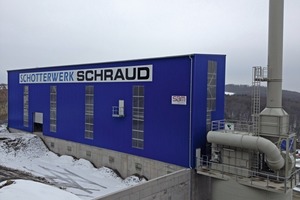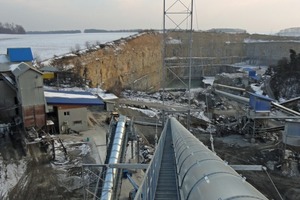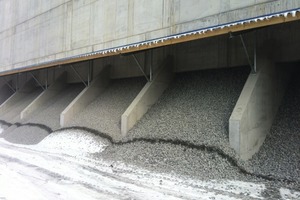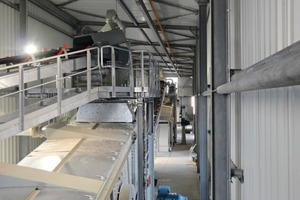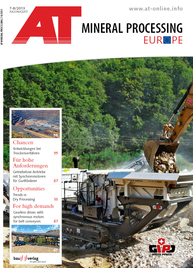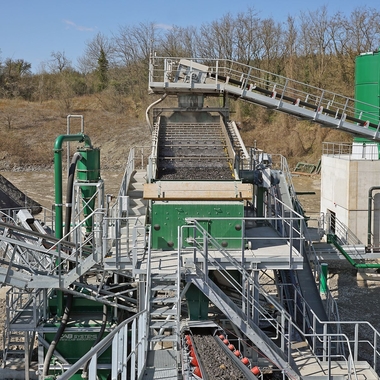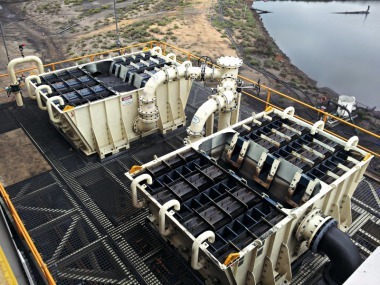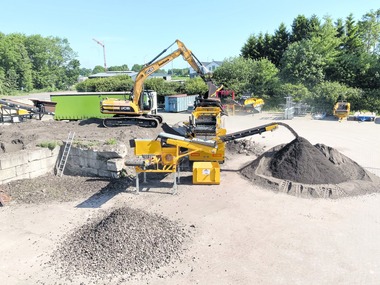Forty years of Schotterwerk Schraud – and an SBM classifier
Schotterwerk Schraud – a company specialising in the preparation of crushed limestone, gravels and sands for highway and paving construction, the concrete and asphalt industries and agriculture – opened in Retzstadt forty years ago. Up to 3000 t are extracted here each day.
Directors Peter and Axel Schraud granted themselves a future-orientated present to mark this round-figure anniversary: the commissioning of a new SBM Mineral Processing heavy-duty classifier, conveyor and loading system at the 25 hectare quarry located to the north of Würzburg (Fig. 1 and Fig. 2). The original classifier had served for forty years and was no longer “fit” for future challenges. “Modernisation was not an economic proposition, so we decided on a complete new system”, explains Axel Schraud, who has been with the company since 1996. The decision in favour of SBM Mineral Processing was an easy one, in view of the good experience already available with preparation technology and crushers supplied by this Austrian specialist. “We had occasionally used mobile SBM crushers on our site to cover production peaks”, adds Schraud. Good co-operation and confidence in SBM’s technical know-how provided further reasons to award this project, too, to SBM.
The interface with the new SBM classifier is the second crushing stage of the existing line. The new 60 m long, 7 m wide and 27 m high installation will be used to grade crushed limestone at a feed size of 0-120 mm into nine individual fractions (Fig. 3). A standby bunker for special products, which can be charged from articulated vehicles, gives this machine extra flexibility. Product quality was, of course, Schraud’s top priority, and a dedusting concept was therefore drawn up with FB Filterbau at the start. The high-performance installation assures production of a low-filler crushed sand, which is recovered by installing classifier tubes into the 0/2 screening hopper. Another result of the optimised dedusting concept is the low fine clogging-particle content of the particle-size fractions.
“A 2.5-deck, a 3-deck and a 2-deck mechanical flip-flow screen, with screen frame dimensions of around 2 x 6 m, has been installed to permit recovery of the target products”, comments Martin Schwab, Regional Marketing at SBM, on the machines selected (Fig. 4). “Each concrete bunker in the generously dimensioned sub-level section is equipped with the metering system necessary to supply 800 tonnes per hour of mixed fractions or single particle-size fractions to the loading belt”.
The question of storage arose at the start of planning, with both silos and concrete bunkers under consideration. A cost appraisal for the required storage volume of 350 m3 per fraction argued clearly in favour of concrete. An additional plus for this variant was wheel-loader accessibility to every concrete bunker, permitting loading of individual fractions using these vehicles, and thus reducing truck waiting times at peak periods significantly, an improvement already much appreciated by haulage operators and drivers alike.
The key components in the conveying, classifying and loading system were designed and produced at SBM, while external partners were co-opted for the dedusting, electrical/control systems, and concreting. „This clear division in construction planning and installation assured conflict-free construction and commissioning for all involved“, emphasises Schwab, assessing the good co-operation achieved between all the participants.
Schraud was at all times aware of the high official requirements concerning noise, particulates emissions, energy-efficiency and occupational safety. As early as the approval phase, the participating companies provided the client with all the information, documentation and technical descriptions necessary to meet the authorities’ requirements and assure fast-track approval. All conditions concerning occupational safety and on-site safety checks during installation and commissioning were met. Another important factor was that the installation be generously and spaciously dimensioned, and assure perfect accessibility to all machinery and components, ultimately making servicing and maintenance quick and easy.

